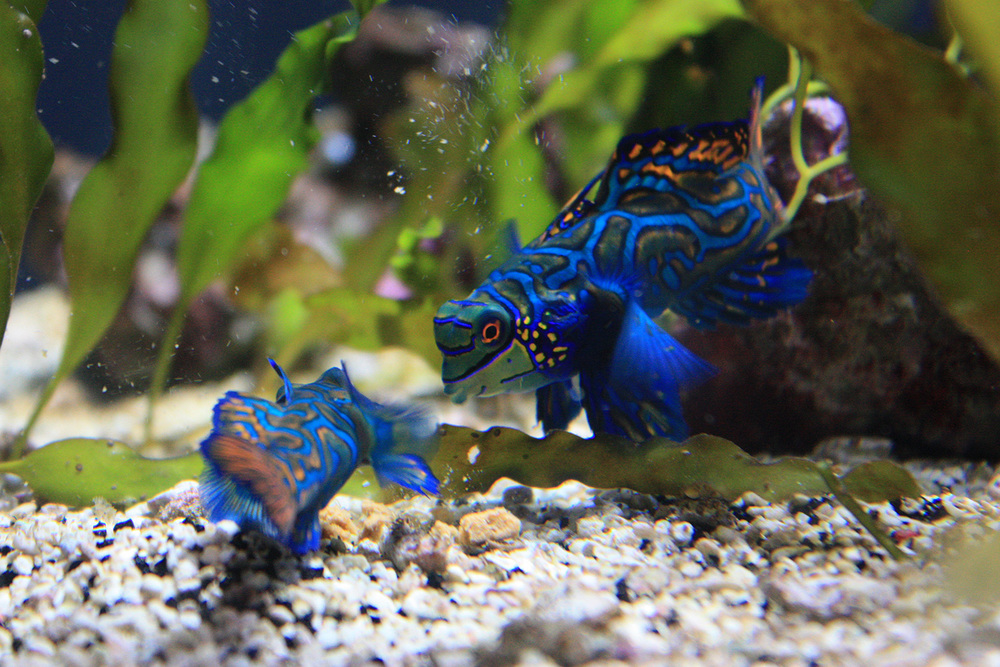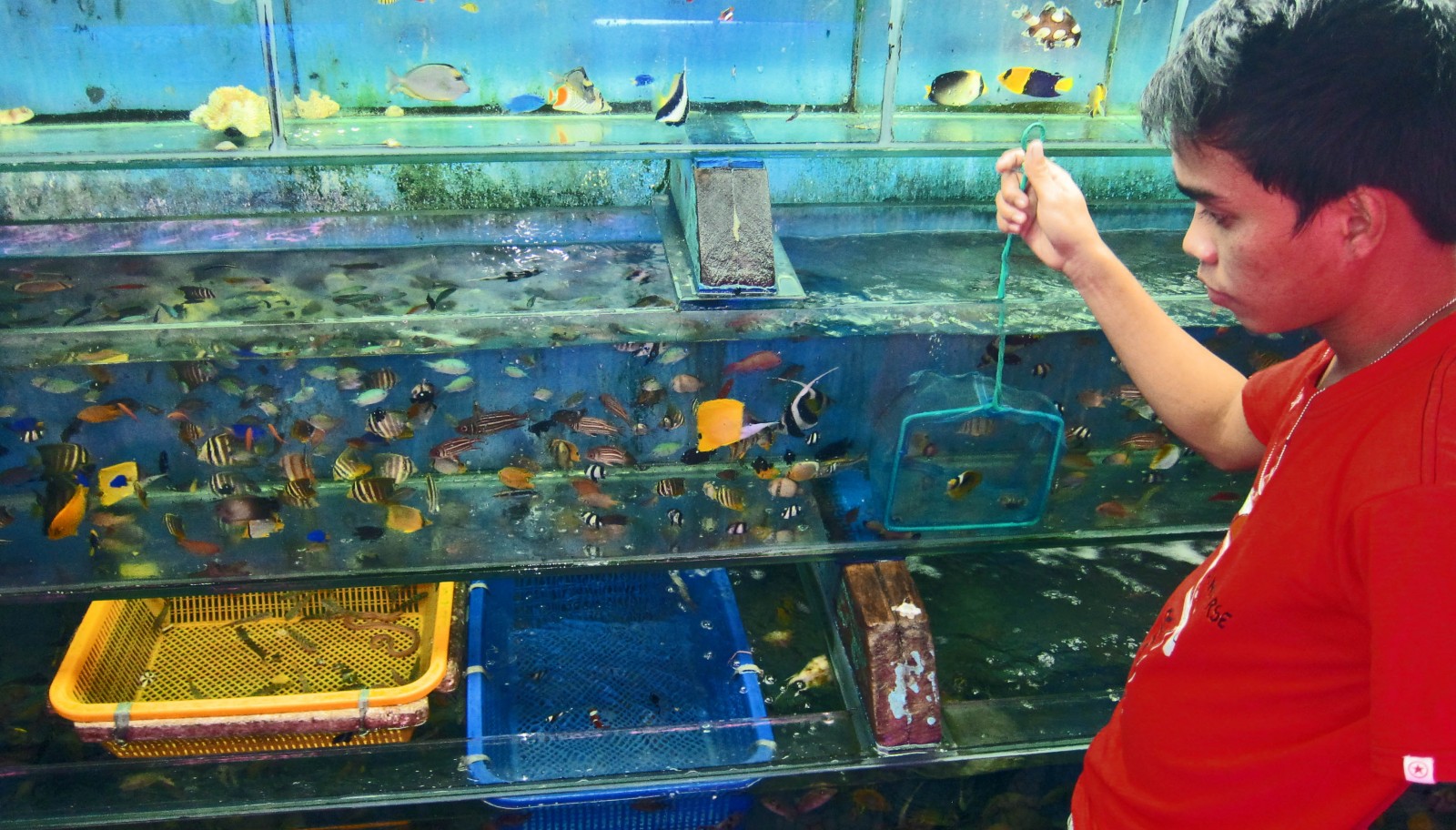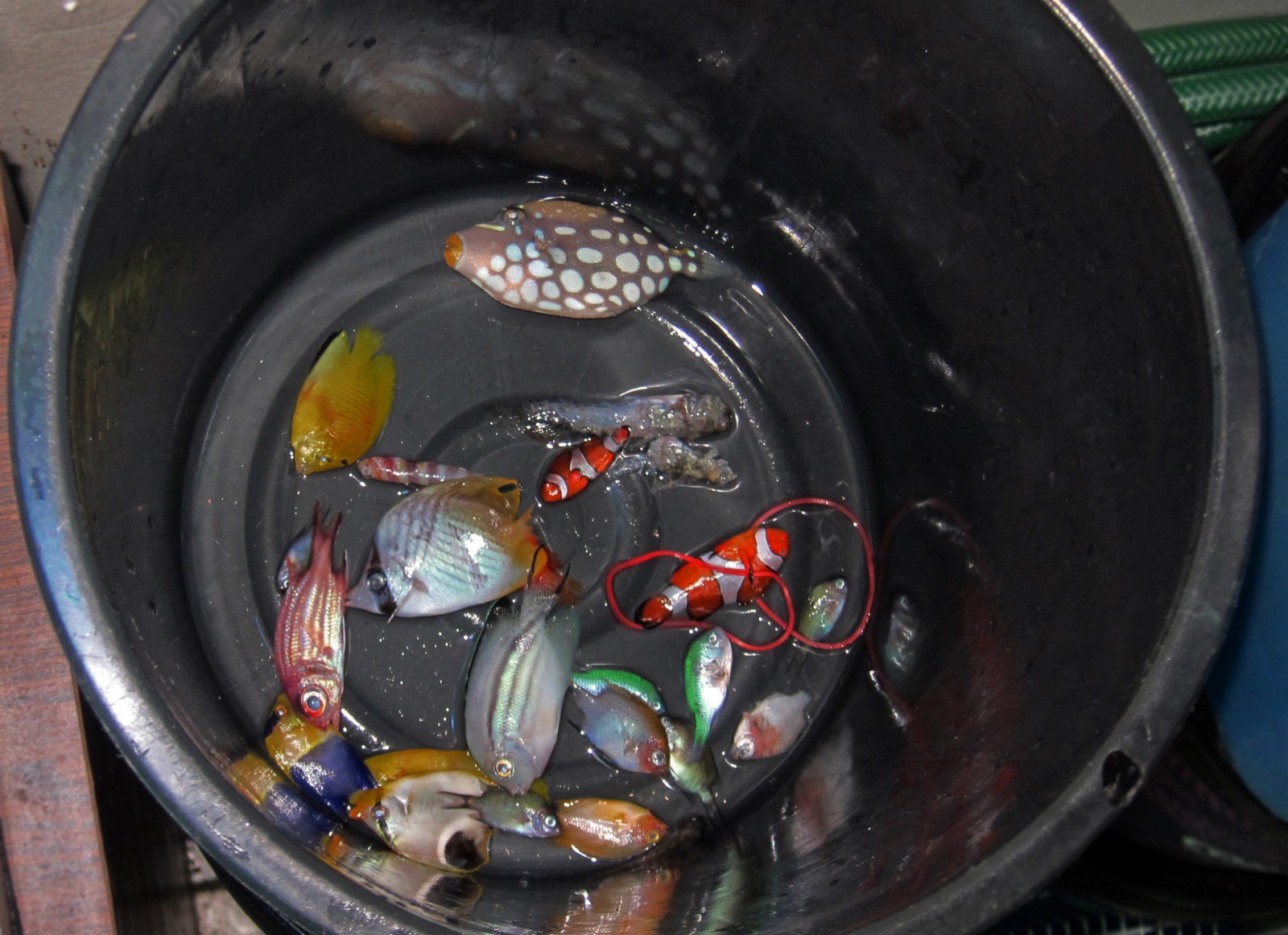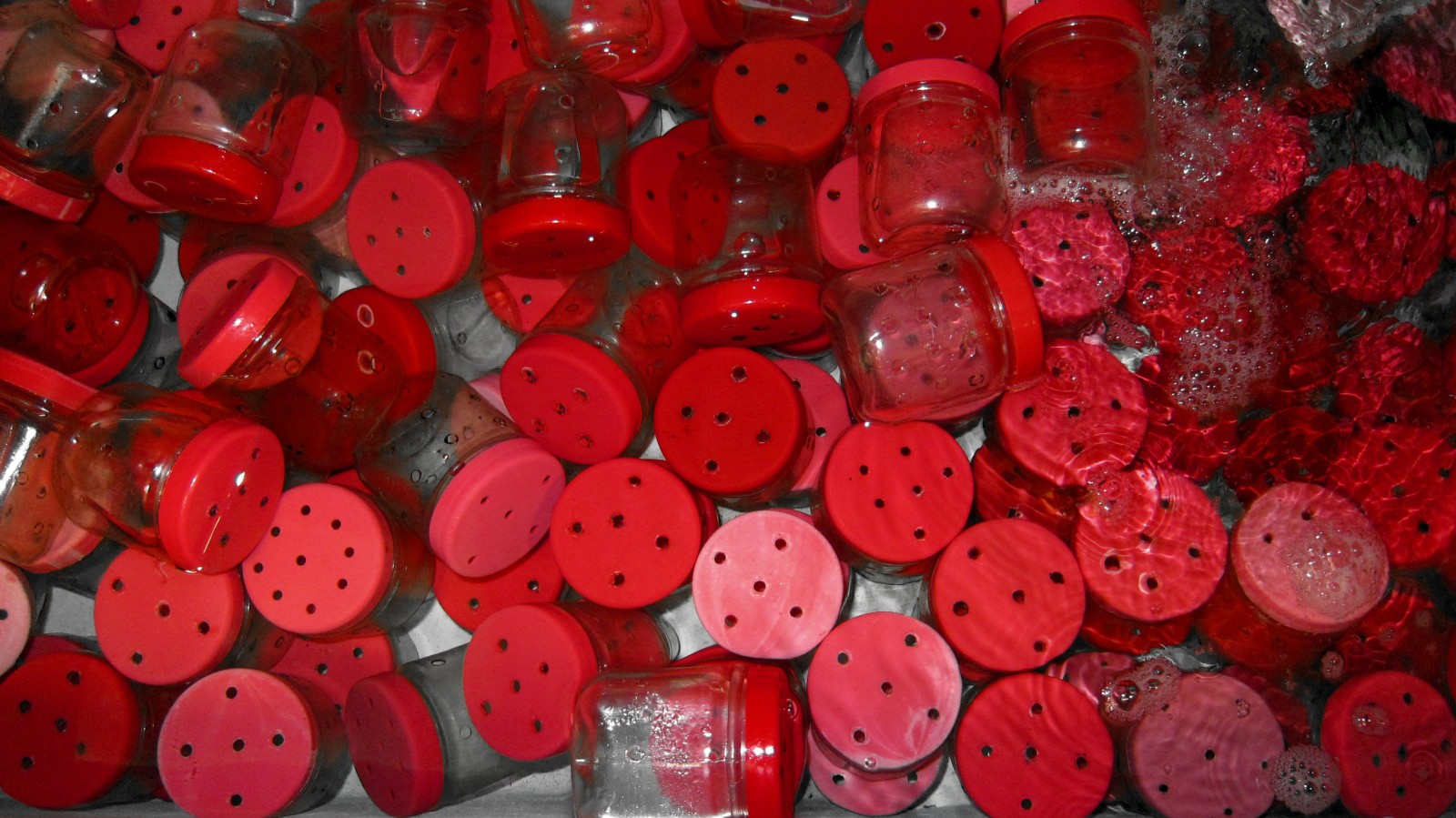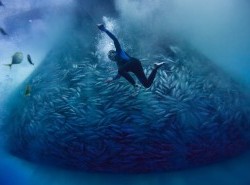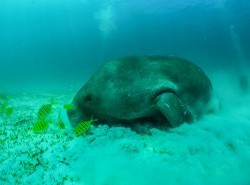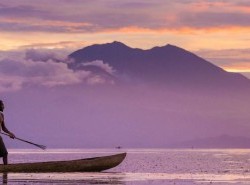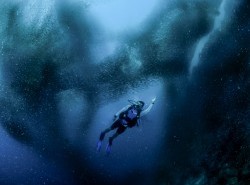In a sweltering concrete block, Crisanto methodically organises his catch into species, while pumps hum and whir, moving water through a maze of acrylic tubes filled with tropical reef fishes in a myriad iridescent colours. Somewhere in his fourties, Crisanto hails from the island of Cebu in the Philippines. He says he's been collecting aquarium fish for almost all his working life...
The Philippines supplies the majority of saltwater aquarium fishes to markets around the world - a fact that came as a great surprise to Crisanto. He was also shocked to discover just how much aquarium hobbyists are prepared to pay for the fish he catches - as much as a hundred times what he gets. What he is constantly aware of however is the poverty all around him - a welter of dilapidated shacks with battered corrugated roofs and torn tarps, piles of rubbish...Statistcs suggest that more than two thirds of families in this region are either poor or low income.
In this hardscrabble setting, it’s hard to conjure the mini reefs reproduced in living rooms of landlocked, well-fed Westerners. Yet that will likely be the final destination for the two-spined angelfish (Centropyge bispinosa) that Crisanto transfers from a tub into a water-filled plastic bag for shipping. After a long flight, the fish will sell to an aquarium hobbyist for up to $40 — close to many Filipinos’ entire weekly earnings. If it makes it, that is. Mortality rates for aquarium fishes are extremely high.
Researchers who study the aquarium trade believe anywhere from 18 to 30 million marine fishes are traded globally each year, but a paucity of data makes it difficult to know the actual volume. We do know that at least 85% of all aquarium fishes sold to to the US come from the Coral Triangle. While some observers argue that the trade can be a force for reef conservation and socio-economic development in places like the Philippines, some of the same voices also caution that the trade as it is currently practiced may be tough on reef ecosystems and fisher communities.
Data is key to putting the trade on a path toward greater sustainability, according to researchers Michael Tlusty of the New England Aquarium in Boston and Andrew Rhyne of the aquarium and Roger Williams University in Bristol, Rhode Island. The pair has developed a new way to collect and interpret information about the diversity and volume of animals in commerce. After successfully using their approach to analyze US imports, they are now cooperating with the Philippines government to assess the world’s most important source country for marine aquarium fishes.
A contentious global industry
The saltwater aquarium trade emerged in the 1930s in Sri Lanka. By the 1970s it had grown into a multi-million-dollar global industry. The trade reached its peak in 2005 then declined, in part due to the global economic downturn. Now numbers appear to be rising again, according to Rhyne.
Their analysis of US import data between 2008 and 2011 shows that nearly 2,300 fish species originating from 45 countries are in trade, most arriving from the Philippines (56%), followed by Indonesia (28%). Fully 85% are wild caught. The majority of the global trade goes to the US (up to 70%) and Europe. Observers note that aquariums are also on the rise across Southeast Asia and especially in China, which could shift trade demographics significantly over the next decade.
The saltwater aquarium trade remains firmly dependent on wild fishes. Some anti-aquarium activists and NGOs contend that the extraction of reef fishes for aquaria is tantamount to a crime against nature. They rely on legislation, litigation, and Endangered Species Act petitions to try to curb or eliminate the trade.
When it comes to the sustainability of the aquarium fishery, there are some examples of localized overfishing. In at least one case — that of one of the most popular aquarium fishes, the Banggai cardinalfish (Pterapogon kauderni) — overfishing caused concern among scientists about the viability of an entire species. Just this week, the US National Marine Fisheries Service (NMFS) listed the Banggai cardinalfish as “threatened” under the Endangered Species Act.
Overall, however, overfishing aquarium fisheries is unlikely given the reproductive biology of many of the most popular species, according to Rhyne: “Many species are traded in such small numbers and are so fecund that few aquarium fisheries could harvest anywhere close to the maximum sustainable yield based on current demand,” he said.
Nonetheless, he cautions that species traded in large numbers, or those harvested from geographically restricted ranges, must be monitored more closely. “The trade only has limited examples of successful management of heavily traded species,” he said.
While 30 million fishes harvested in a year sounds like a lot, especially on top of well-documented reef stressors like coral bleaching and ocean acidification, it pales in comparison to food fisheries, where the accidental bycatch alone is far greater than the entire aquarium fishery harvest.
the scientists believe closing marine aquarium fisheries could have serious consequences for fishers as well as for reefs
Still there is widespread illegal, unreported, and unregulated fishing. These include the ongoing use of cyanide to stun fishes despite PR campaigns to end the practice and laws making it illegal in the two largest source countries. They acknowledge that localized overfishing has forced fishers in some areas to go farther afield to find high-value species like the blue tang (Paracanthurus hepatus).
On the import side, those familiar with marine aquarium fish shipments say misidentified and improperly declared animals remain too common, in some cases representing a clear effort to subvert regulations and restrictions. Many observers agree that efforts to reform the trade have largely failed owing to a lack of transparency and to the fact that the most important source countries have poor track records when it comes to illegal wildlife trafficking.
Tlusty and Rhyne share some of these concerns. But the scientists believe that closing marine aquarium fisheries could have serious consequences for fishers like Crisanto, as well as for reefs. They argue that a low-biomass, high-value fishery like an aquarium fishery can actually motivate people to harvest sustainably and to conserve coral reefs.
A need for data
For more than a decade, researchers have been discussing the lack of sufficient marine aquarium trade data. “When you don’t even know how many animals are being exported from a given country, how can you begin to assess whether that number is sustainable or not?” Rhyne said.
The tools Rhyne and Tlusty have developed originate in a database created by the National Oceanic and Atmospheric Administration (NOAA). Andrew Bruckner, a coral reef ecologist working for the NOAA at the time, realised the Law Enforcement Management Information System (LEMIS) lumped aquarium fishes together in a single generic code. However, the commercial invoices for imports identify fish down to species level, so Bruckner set about digitising what was at the time paper data. Rhyne took over the task in 2008, developing character recognition software that could identify errors and verify species names. The end result was the Marine Aquarium Biodiversity and Trade Flow database published last summer.
In addition to providing invaluable and previously unavailable data on the aquarium trade, those charged with overseeing other aspects of the wildlife trade also see the utility of Rhyne and Tlusty’s system. A real-time, tablet-based version of the technology could increase the efficacy of wildlife inspectors at ports of entry and help identify illegal trade, for instance. The work recently earned the New England Aquarium a finalist slot in USAID’s Wildlife Crime Tech Challenge, a contest that rewards science and technology innovations to combat wildlife trafficking.
“This database is the starting point for increasing the sustainability of the trade,” Rhyne said, “Once we know the volume and diversity of the trade, we can tackle other relevant issues that lead to environmental and economic benefits.”
Taking the system to the reef
Rhyne and his colleagues are now assisting the Philippine Bureau of Fisheries and Aquatic Resources (BFAR) in collecting and analysing export data with their new system. The project is funded through a roughly $50,000 NOAA grant and will provide at least one year’s worth of export data from the Philippines.
The Philippine government’s willingness to collaborate with Rhyne and his colleagues is a potential game-changer for the embattled marine aquarium trade. If the largest source country can carry out data-based reform, such as implementing data-based fisheries management and more effectively regulating exports, the trade could demonstrate it is on a path to greater sustainability that can benefit fishers, fisher communities, and reefs.
The Philippine Undersecretary for Fisheries, Asis Perez, has been the driving force behind the country’s participation. In his first months on the job, Perez took a closer look at the aquarium fishery, and what he learned was similar to what Rhyne and Tlusty believe — that a sustainable aquarium fishery can be a force for lifting coastal people out of poverty and conserving reefs.
“I told [the aquarium fishers] the mandate of our president is very, very clear — to take out all unsustainable practices because in the long run it creates poverty.”
The application of big data matched with this kind of political will presents an opportunity to develop a genuinely sustainable aquarium industry.
This is an abridged version of an article originally published by Mongabay
